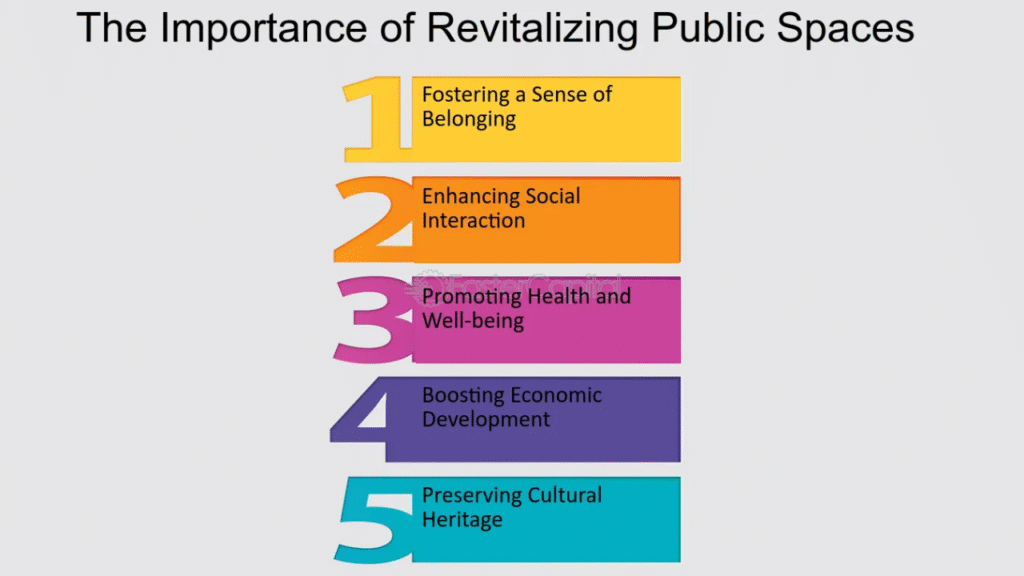
Urban public spaces are the soul of any city—parks, plazas, streets, and alleys that serve as gathering places, cultural stages, and breathing rooms. Yet, many of these spaces have fallen into disrepair or have become disconnected from the communities they were meant to serve. Today, a powerful shift is underway: communities are reclaiming these spaces through inclusive, participatory design. This article explores how revitalizing urban public spaces through community design enhances social connection, boosts safety, supports equity, and reflects the identity of the people who live there.
Overview Table: Key Aspects of Community Design in Public Space Revitalization
| Aspect | Role in Urban Revitalization |
|---|---|
| Participatory Planning | Ensures designs meet real community needs |
| Placemaking | Strengthens local identity and cultural expression |
| Green Infrastructure | Enhances climate resilience and health |
| Safety and Accessibility | Makes public spaces welcoming for all |
| Tactical Urbanism | Offers low-cost, fast ways to test design interventions |
| Inclusive Engagement | Gives voice to marginalized or underrepresented groups |
1. Participatory Planning: Design by the People, for the People
Community design starts with listening. Participatory planning invites residents to be co-creators—not just users—of public spaces. This process builds trust, fosters a sense of ownership, and often results in more successful, sustainable outcomes.
Methods for participatory planning include:
- Community design charrettes
- Interactive mapping and walk-throughs
- Public visioning workshops
- Surveys and feedback stations in local languages
By prioritizing local knowledge, planners ensure designs align with daily life, cultural traditions, and specific neighborhood challenges.
2. Placemaking as a Tool for Connection and Pride
Placemaking turns generic spaces into places of meaning. It integrates art, culture, and local identity into the design process, resulting in environments that reflect the character of the neighborhood.
Key placemaking tactics:
- Murals and public art by local artists
- Signage in native languages
- Celebrating community stories and heritage through design
- Flexible spaces for events, festivals, and markets
This approach boosts community pride and fosters connections between residents who may not otherwise interact.
3. Green Infrastructure and Environmental Benefits
Revitalizing public spaces with green design improves not just aesthetics but also urban sustainability and health. Integrating green infrastructure contributes to climate adaptation and biodiversity while providing shaded, breathable environments.
Green design elements include:
- Tree planting and native landscaping
- Rain gardens and bioswales for stormwater management
- Permeable pavements
- Urban gardens and edible landscapes
In neighborhoods with limited access to green space, these interventions can dramatically improve air quality and mental well-being.
4. Safety, Accessibility, and Universal Design
Poorly maintained or uninviting spaces can lead to neglect, crime, and exclusion. Community-driven design prioritizes universal accessibility and perceived safety, making everyone feel welcome.
Strategies to enhance safety and access:
- Open sight lines and lighting improvements
- Seating and play areas for different age groups
- Clear signage and pedestrian pathways
- Accessibility features for people with disabilities
When everyone feels safe and included, usage increases and the space becomes more vibrant and self-sustaining.
5. Tactical Urbanism: Testing Ideas Before Full Investment
Tactical urbanism uses temporary, low-cost projects to prototype ideas. This agile approach allows communities to test interventions and gather feedback before committing to permanent infrastructure.
Examples of tactical projects:
- Pop-up parks or seating areas
- Painted crosswalks and traffic calming
- Mobile shade structures or kiosks
- Temporary art installations
These small wins generate excitement, build momentum, and help secure long-term funding or policy support.
6. Inclusive Engagement: Uplifting Every Voice
A truly community-driven design process goes beyond token consultation—it actively reaches out to underrepresented and vulnerable groups, including youth, elders, immigrants, people with disabilities, and low-income residents.
Engagement tools may include:
- Youth-led walk audits and design competitions
- Multilingual facilitators and materials
- Partnerships with local NGOs or cultural leaders
- Creative outreach via music, food, or mobile installations
Such efforts ensure that the redesigned space meets the diverse needs of all users, not just the vocal or privileged few.
Table: Before and After – Impact of Community-Led Urban Space Revitalization
| Feature | Before Revitalization | After Community Design |
|---|---|---|
| Lighting & Safety | Poor lighting, vandalism | Safe lighting, community surveillance |
| Accessibility | Limited access, poor pathways | ADA-compliant walkways and entries |
| Aesthetic Appeal | Dull, littered, or underused | Artistic, clean, and lively |
| Community Engagement | Top-down planning, lack of input | Inclusive design workshops and feedback |
| Environmental Features | Concrete-heavy, little greenery | Rain gardens, shade trees, bioswales |
| Usage | Rarely used or avoided | Active with families, vendors, youth |
3 Best One-Line FAQs
1. How does community design improve urban public spaces?
By aligning design with local needs, values, and culture, public spaces become safer, livelier, and more inclusive.
2. Can revitalization be done with limited budgets?
Yes—tactical urbanism and community partnerships enable impactful, low-cost improvements.
3. What makes a public space truly inclusive?
Accessibility, safety, cultural relevance, and the active involvement of all user groups in the design process.
Conclusion
Revitalizing urban public spaces through community design is more than an aesthetic upgrade—it’s a social, environmental, and democratic intervention. By giving residents a seat at the design table, cities can create spaces that reflect shared values, foster belonging, and spark long-term transformation. In a time when urban inequality and environmental stress are growing, community-led public space design offers a hopeful, human-centered path forward.

